Although chapbooks and children's books comprise two distinct literary categories, they are often grouped together based on their similar size, content, and assumed readership. As a literary category, the term "children's books" is rather vague as it can apply to works that were read by children, as well as works that were written for children. Although it generally refers to the latter, it has often been extended to include works that were produced for adult audiences but read and enjoyed by children, such as Robinson Crusoe (1719) and Gulliver's Travels (1726); it can also refer to books of instruction that were read unwillingly at Sunday school, or "jest books subversively enjoyed at home" (Grenby 277). In its current use, the term typically refers to a type of literature that did not exist prior to the eighteenth century. F.J. Harvey Darton defines children's books as printed works that were "produced ostensibly to give children spontaneous pleasure, and not primarily to teach them, nor solely to make them good, nor to keep them profitably quiet" (Darton 1). It is to this characterization that the modern use of the term typically refers. For the purpose of convenience, many critics, including Darton, have adopted the 1744 publication of John Newbery's A Pretty Little Pocket Book as the genesis of modern children's literature.
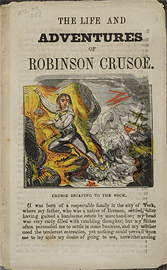
PN970 A1 D44 1840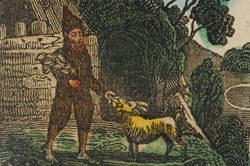
PN970 R87 H57 1820
There had, of course, already been plenty of books written for child audiences by 1744, but Newbery is often singled out because he was one of the first publishers that "deliberately set out to…[amuse]" (Darton2). Prior to the publication of A Pretty Little Pocket Book , the majority of books written for children would have served a purely instructional purpose—conduct guides, manuals, ABC's, primers and catechisms—and would hardly have been regarded as sources of entertainment. There were some books intended for the amusement of children prior to 1744, but they were not recognized as a "clear but subordinate branch of English literature until the middle of the eighteenth century" (Darton 1). For example, Thomas Boreman published A Description of Three Hundred Animals in 1730, fourteen years before Newbery's first children's book, and Mary Cooper published The Child's New Play-thing: Being A Spelling Book Intended To Make Learning to Read a Diversion Instead of a Task in 1742, which, because of its similar content, is widely considered to have pre-empted A Pretty Little Pocket Book (1744) as the first book written for the combined instruction and delight of children. In other words, although Newbery is commonly acknowledged as the first publisher to recognize the market potential of children's books, he was exploiting a form of literature that had already existed for decades in its nascent form. In this regard, Darton's assertion that children's literature commenced with the publication of Newbery's first children’s book relies less on the appearance of a certain type of content than on the establishment of a separate and secure market niche for juvenile literature.
The earliest children’s books would have been virtually indistinguishable from chapbooks because they maintained the same basic appearance and format. They were printed on cheap paper in duodecimal volumes and featured woodcuts that had been "obviously recycled from other publications" (O'Malley 21). Furthermore, although chapbooks predate what we would commonly call children's literature by over two centuries, it is not uncommon to find revised or remediated versions of chapbooks in 18th and 19th century collections intended for children. This is because, much like the chapbooks that preceded them, children’s books featured derivative stories that owed more to the collective oral tradition of the sixteenth and seventeenth centuries than to the imagination of any individual writer.
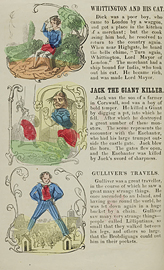
PN970 P37 P37 1836Despite these similarities, children's books tended to be shorter and better printed than chapbooks; by the early nineteenth century they were made with higher quality paper, featured coloured woodcuts on each page, and at only 6-9 cm high and 4-6 cm broad, they were smaller than most chapbooks. Children's books were also less available than chapbooks because they were not distributed by the network of chapmen, but through the "normal range of retail outlets" (Grenby 291). As a result, the children's book trade took much longer to reach the provinces and children's books published by rural printing houses—generally lacking moral instruction—were a decidedly different product from those published at the core of the children's book trade in London. The most striking difference between chapbooks and children's books, however, is the change in content. Unlike chapbooks, which were intended purely for entertainment, these new children's books combined instruction with delight, and featured "[short] moral tales and didactic fictions… as frequently as fairy stories and legendary tales" (Grenby 291). This new pedagogical aspect, while not entirely replacing the residual chapbook themes, was intended to moralize the tales and offer lessons for the improvement of children.
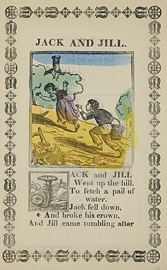
PN970 F6 H55 1860
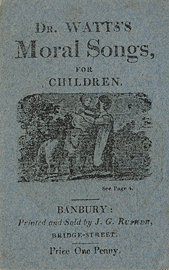
PN970 R87 D7 1820 Most critics agree that, prior to the establishment of a juvenile literature designed specifically for entertainment, children would indulge in amusing tales and verses printed in the only format available to them: the chapbook. For example, Grenby asserts that children routinely read chapbooks throughout the sixteenth, seventeenth, and eighteenth centuries and, as late as 1800, were "just as likely to have bought their own chapbooks as to have acquired them as gifts or as teaching tools" (Grenby 290).
Indeed, evidence from memoirs and autobiographies suggests that up until the mid eighteenth century, children constituted a significant portion of the chapbook market. The earliest example of this comes from Robert Ashley’s memoirs, in which he recounts reading such chapbooks as Bevis of Hampton, Guy of Warwick, and Valentine and Orson while attending Oxford in the late sixteenth century. A later testimony from Samuel Johnson describes how, as an infant in the early eighteenth century, he had delighted in reading St George and the Dragon. By the early nineteenth century, however, accounts of this type become laden with fond reminiscences of authors’ own childhood chapbook readings, "often written as if chapbooks were a thing of the past" (Grenby 286). In The Prelude (1805), William Wordsworth laments the early nineteenth-century emergence of serious, didactic children's books in place of the familiar chapbook titles of his youth: "Oh! Give us once again the Wishing-Cap / Of Fortunatus, and his invisible Coat / Of Jack the Giant-Killer, Robin-Hood, / And Sabra in the forest with St. George! / The child, whose love is here, at least doth reap / One precious gain, that he forgets himself" (Wordsworth 5.341-6).
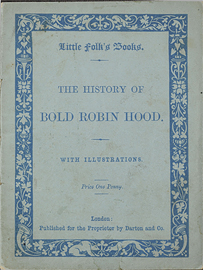
PN970 D37 H5 1845Similar accounts from John Clare and Charles Dickens suggest that a new form of serious, moral, and didactic children's literature had superseded chapbooks as the primary reading material of children. The problem is that Clare and Dickens were writing decades apart from Wordsworth and from each other. Wordsworth was lamenting the demise of chapbooks in the first decades of the nineteenth century, but this is precisely when Clare was claiming to have read them, and Clare insisted that chapbooks had died out by the 1820s, which is when a young Dickens had been enjoying them. Despite the apparent contradiction in these accounts, Grenby points out that Wordsworth, Clare and Dickens were from comparatively different backgrounds; Wordsworth came from a prosperous family, but Clare and Dickens were relatively poor. This has led to two important conclusions: first, Wordsworth's claim that chapbooks had been displaced by a new kind of didactic children's literature "applied only to the fairly privileged" (Grenby 289). And second, the demise of children's chapbook reading was a protracted process, lasting "well over half a century" (Grenby 289).
Other evidence of children's chapbook reading includes fictionalized accounts, as well as surviving records from libraries and printing houses. However, the strongest evidence that children read chapbooks comes, rather ironically, from the overwhelming condemnation of children's chapbook reading. Chapbooks were seen as a negative influence on the moral and educational development of children and, although they were certainly read by children, they were not regarded as children's literature. Beginning in the latter half of the seventeenth century, but increasingly in the eighteenth, there grew the idea that children should be provided with a literature of their own that would provide instruction as well as delight. Many critics have even suggested that children's literature emerged out of the opposition between the chapbook and the didactic moral tale. Andrew O'Malley, for instance, asserts that children's books of the eighteenth century, while retaining the basic format and appearance of chapbooks, were actually vehicles of "middle-class ideology," (O'Malley 22) and were designed to challenge and replace chapbook literature as the primary reading material of children. Basing his argument heavily on the output of the Newbery and Marshall publishing houses, O’Malley claims that eighteenth-century children’s books were hostile to aristocratic values and suspicious of plebeian culture. According to his analysis, the supersession of the chapbook by the new children's literature—a protracted process that began with the publication of Newbery's first children's book and lasted until the 1790s—was also generative of a new type of publication, which he dubs "transitional" or "hybrid" books (O'Malley 18). In these hybrid books two ideologies coexisted uneasily: the "plebeian moral economy" (O'Malley 20) of traditional chapbooks and an emergent middle-class pedagogy that emphasized "a clear bourgeois work-and-reward ethos" (Grenby 296). O'Malley argues that hybrid books existed alongside chapbooks until the early nineteenth century when higher quality children's books rendered both obsolete. However, the supersession argument has met with stern criticism for oversimplifying the relationship between chapbooks and children's literature. According to Grenby, O'Malley's approach fails to account for the mixed roots of children’s literature, and the continued success of chapbooks alongside children's books in early nineteenth-century literary markets.

PN970 B76 L58 1862
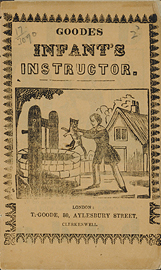
PN970 G6 G66 1829
| < Prev | Next > |


